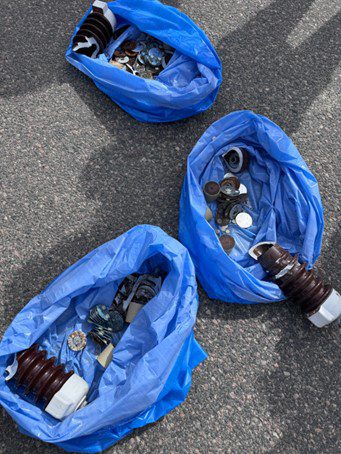Conducting root cause analysis of incidents in the electrical grid is essential in understanding the underlying dynamics of the system, reducing the risk of reoccurring issues, and improving resilience. However, this process can be challenging and time-consuming.
To overcome this, Finnish DSO Vakka-Suomen Voima (VSV) implemented dLab’s dInsight Analytics Platform, which significantly streamlines investigation time and makes root cause analysis more manageable.

Summary
dLab’s root cause analysis quickly uncovered the complex sequence of events behind a three-hour disturbance involving three feeders, a tree branch, a faulty surge arrestor, a mis-calculated earth fault direction by a protection relay, and a cross-country earth fault. The investigation was completed within three hours.
dLab’s platform provides VSV the capability to considerably shorten the time taken to conduct root cause analysis, primarily due to utilization of high-resolution data, automatic analysis and classification tools, and a substation macro perspective.
- The high-resolution data provides a level of detail allowing for the identification of subtle indicators that would have been missed using traditional analytics.
- The automatic analysis and classification tools contribute to a faster process by automating data aggregation, contextualization of the fault, and visualization.
- The macro perspective helps to contextualize the issue at hand within the larger system, providing a broader understanding of the factors that may have contributed to the problem.
The combination of these features significantly expedites root cause analysis, which can have a substantial impact on reducing downtime and improving system performance.
Background
dLab’s Intelligent Platform offers a cutting-edge solution for tracking events in an efficient, systematic, and organized way, allowing for quick pattern identification and a comprehensive understanding of the sequence of events. This was further demonstrated in a recent incident at one of VSV’s substations, where the platform successfully navigated a highly complex sequence of events.
By integrating dLab’s software platform with the dBox hardware, a more sophisticated digital twin of the protection relays can be created. This combination offers numerous benefits, as demonstrated by this case study, including:
- Simultaneous and time synchronized recording of disturbance information from all feeders in a station at any given event facilitates for an investigation of the recordings side-by-side.
- Intermittent faults are captured, and accurate identification of the direction of the earth faults.
- No risk of data loss during long-lasting faults.
The chain of events – a deep dive
During the fourth week of 2023, a complex series of events occurred at one of VSV’s substations, caused by a combination of a single disturbance and a malfunctioning surge arrestor (voltage protector). The events affected three different feeders and lasted for approximately three hours.
The sequence of events began with an earth fault in feeder J06 phase 3 caused by a tree branch, then, after approximately one-third of a second, followed by another earth fault, now in the adjacent feeder J02 phase 2. This second fault was located in a surge arrestor and resulted from a malfunction in the arrestor causing a flash-over when the voltage increased in the healthy phases due to the earth fault in J06.
This event is a typical example of a cross-country fault between J06 and J02, which creates a two-phase short circuit that travels through the ground between the feeders. As a result, both feeders in the station tripped. The current was around 730 A RMS.

The first earth fault transient in J06 can be seen to the left in the diagram above, then at the second transient, the fault in J02 starts. Looking at the voltage in the below graph, the peak voltage in phase 2 was quite high, and this was too much for the surge arrestor. Even if the surge arrestor might have been designed to start leading at this voltage level, what happened next was not within specifications which indicates a failure.

A few minutes later, J02 was re-energized, but the earth fault in phase 2 persisted for just over one second. The fault then developed into a two-phase short circuit between phase 2 and 3, lasting for approximately half a second before being cleared by the overcurrent protection. The current was about 970 A RMS.

As seen in the picture below, the earth fault in the surge arrestor evolved into a short circuit involving the surge arrestor in the adjacent phase.

During troubleshooting the feeder was re-energized with the fault still present a few times before the fault was isolated and the rest of J02 then remained successfully re-energized.
However, approximately an hour and a half later, the first fault in J06 reoccurred as an intermittent earth fault, causing a trip of J06 and an unexpected trip of another feeder, J03. The trip in J03 likely occurred due to incorrect calculation of the direction of the earth fault by the protection relay. The dLab system accurately identified this issue as a fault in J06, a conclusion that otherwise can be quite time‑consuming to come to by manual analysis.
J03 was re‑energized without issues since there was no fault present on this feeder. After sectioning and a few attempts to re-energize J06 the faulty section was isolated, and the rest of the feeder was back in service again. The tree branch was found and removed, and that section of the line could also be taken back in service.

